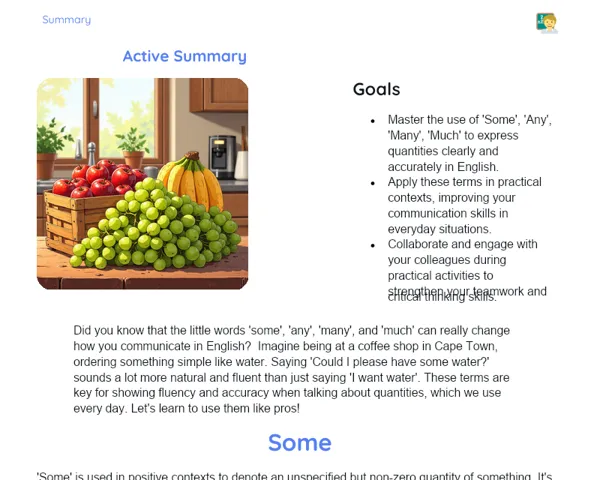Socioemotional Summary Conclusion
Goals
1. Understand what negative sentences are in English and how to spot them.
2. Learn how to accurately convert affirmative sentences into negative ones.
3. Cultivate self-control and reflective skills when it comes to your own emotions during the learning journey.
4. Enhance collaborative and empathetic communication through pair work and group discussions.
Contextualization
Did you know that negative sentences are vital in our daily conversations? Imagine being in a setting where English is spoken and needing to say, 'I don't like apples.' Mastering the way to construct that sentence can prevent mix-ups and make your interactions far more effective! Let’s dive into how we can turn affirmative statements into negatives while also honing our socio-emotional skills for more mindful and empathetic communication. 🚀
Exercising Your Knowledge
Definition of Negative Sentences
Negative sentences convey denial, disagreement, or the absence of something. In English, these sentences are crucial for clear communication, allowing you to express that something doesn’t happen, isn’t true, or isn’t present.
-
Negation Words: Words like 'not', 'never', 'nobody', and 'no one' help form negative sentences.
-
Change of Meaning: Turning an affirmative sentence into a negative one changes its overall meaning, for instance, 'I like apples' becomes 'I do not like apples.'
-
Importance in Communication: Knowing how to construct negative sentences properly can avert misunderstandings and enhance communication quality.
Structure of Negative Sentences
Negative sentences in English have a specific structure based on the verb tense. In the simple present tense, we use 'do/does + not' before the main verb, while in simple past, we use 'did + not'. Understanding these structures is key to forming negative sentences correctly.
-
Simple Present: The structure follows 'Subject + do/does + not + main verb'. Example: 'She does not like pizza.'
-
Simple Past: The structure is 'Subject + did + not + main verb'. Example: 'They did not go to the park.'
-
Contractions: In informal chats, contractions like 'don't' and 'doesn't' are common. Example: 'I don't like apples.'
Use of Auxiliary Verbs
The auxiliary verbs 'do', 'does', and 'did' are critical for forming negative sentences in both the simple present and past tenses. They don’t have meaning on their own but are essential for constructing the negative form.
-
Simple Present: Use 'do' with 'I', 'you', 'we', 'they', and 'does' with 'he', 'she', 'it'.
-
Simple Past: 'Did' is used for all subjects.
-
Importance: Without these auxiliary verbs, the negative sentence won’t be grammatically sound.
Key Terms
-
Negative Sentences
-
Auxiliary Verbs
-
Contractions
-
Simple Present
-
Simple Past
For Reflection
-
How do you handle situations where you need to say no or disagree with someone? Consider how clear communication can help clear up misunderstandings.
-
Were there any moments of frustration or confusion while changing affirmative sentences into negatives? How did you cope with those feelings?
-
Working with a partner often requires a bit of patience and understanding. What was your experience like while teaming up to change sentences? What socio-emotional skills do you think you developed?
Important Conclusions
-
Negative sentences are key for effective communication in English, letting us clearly express denials and disagreements.
-
Grasping the structure and function of auxiliary verbs is essential for correctly forming negative sentences in simple present and simple past.
-
The process of flipping affirmative statements into negatives not only builds language skills but also develops socio-emotional abilities like self-awareness and emotional regulation.
-
Collaborating in pairs and taking part in group discussions fosters empathetic communication and a deeper understanding of others' feelings.
Impacts on Society
Negative sentences greatly influence society, particularly in how we communicate and understand each other. By mastering the formation of negative sentences, you can dodge misunderstandings in everyday scenarios, be it expressing your food preferences, disagreeing with an opinion, or clarifying that something didn't happen. This can significantly enhance your social interactions, making your communications more precise and impactful.
Also, the capability to form negative sentences is closely linked to self-awareness and emotional intelligence. Recognising how and when to use these sentences enables you to communicate in a more thoughtful and empathetic manner. This not only shapes your personal relationships but also nurtures a more understanding and respectful environment, both academically and personally.
Dealing with Emotions
To manage your emotions while learning about negative sentences, I suggest using the RULER method as you review the content. First, recognise the emotions you experience while studying (Recognise). Then, try to understand the triggers behind those emotions and their effects (Understand). Accurately label those emotions, whether it’s frustration, satisfaction, or curiosity (Label). Share your feelings appropriately, perhaps through writing or discussing them with a peer (Express). Lastly, regulate your emotions by using techniques like deep breathing or taking quick breaks during your study sessions (Regulate). This approach will boost your self-control and make the learning process more enjoyable and effective.
Study Tips
-
Create flashcards with affirmative sentences and practise turning them into negatives. This will help solidify your knowledge and make studying more interactive and enjoyable!
-
Engage in active listening by watching English videos and identifying negative sentences. This will not only enhance your listening skills but also help you recognise speech patterns.
-
Develop short dialogues with a friend or classmate that incorporate negative sentences. This practice will bolster effective communication and help reinforce the content in a practical and collaborative manner.



